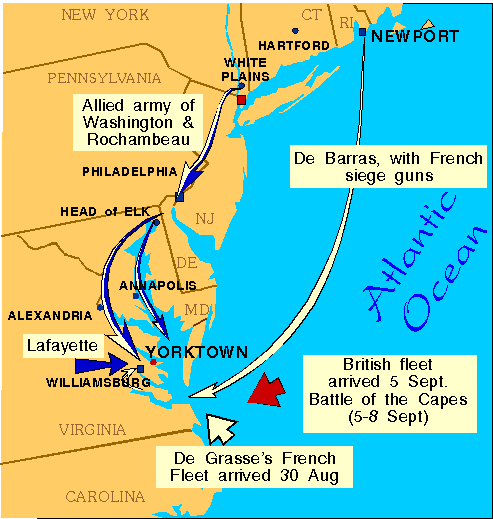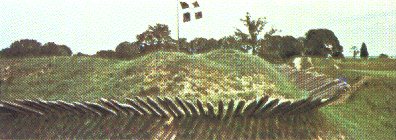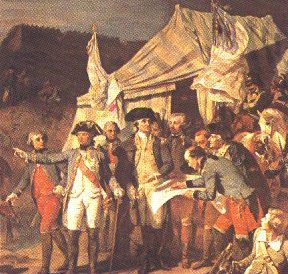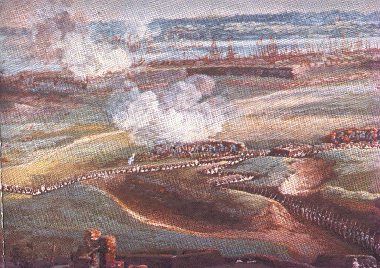
MILITARY HISTORY DATABASE
|
YORKTOWN
CAMPAIGN
(August-October 1781)
|
Detail from a 1836 painting by A. Couder; held by Musée National de Versailles.
|
The commemorative (and romanticized) painting of the allied headquarter's staff depicts generals Rochambeau and Washington, who along with Admiral De Grasse can be credited with conducting the exemplary combined and joint military operations in the Yorktown Campaign of 1781. It was a tribute to their individual characters and professionalism that the complexities of such operations succeeded, given that neither of the army commanders spoke the language of the other.
|
DIRECTORY
|
|
|
Strategic Aspects:
- ARRIVAL of FRENCH EXPEDITION
- ALLIED CONFERENCES
- RECONNAISANCE of NEW YORK
- SOUTHERN OPERATIONS in VIRGINIA
- DE GRASSE ARRIVES from the WEST INDIES
- 10 July 1780
- French squadron, under de Ternay, escorting transports carrying Rochambeau's expedition arrived off Rhode Island coast. Rochambeau disembarked at Newport 12 July.
For the remainder of the year, the French expedition took no military action. At their main camp near Newport, the French established a reputation of being a highly discplined force, and were eventually well received by the local citizens. The French hussar cavalry acquired horses [they departed France with none] and camped for the winter at Lebanon, CT, where there was better forage conditions.
- 20-22 September 1780
- Washington and Rochambeau first met at Hartford, CT, mid way between the American and French camps.
- 13 February 1781
- French squadron under naval Captain de Tilly slipped past a British 'blockade' of Newport and headed to Virginia to go against Benedict Arnold, whom Clinton had sent south in December 1780. Tilly entered the Chesapeake and anchored at Lynnhaven Bay. Having taken a few small British ships, Tilly's squadron returned to Newport 24 Feb.
- 16 March
- "First Battle of the Virginia Capes" fought between French Destouches and English Arbutnot. After an indecisive naval engagement, Arbutnot quickly positioned his damaged squadron at the mouth of the Chesapeake. Destouches did not believe that his damaged squadron could force the break the British line. Result was that the British prevented French entering the Chesapeake. French returned to Newport on 26 March. Lafayette had been sent to Virginia by Washington with an American force to have worked with French troops from Destouches' squadron.
- 10 May
- French frigate arrived into Newport with Vicomte de Rochambeau and Comte de Barras, who had been sent to take over command of the French naval squadron under Destouches. Also, Rochambeau received word that the large French fleet under De Grasse "would be available for operations on North American coast" beginning in July or August.
- 21-23 May 1781
- Washington and Rochambeau met at Wethersfield, CT. Chastellux, Knox, Duportail were present.
- 10 June
- Rochambeau forwarded De Grasse's letter to Washington.
French army left Newport. Rochambeau gave 700 men to Barras to help man the warships; another 400 were left under de Choisy as a nucleus of the Newport garrison (there was also the American militia at Newport). When some replacments joined them at Providence, the French army of march had no more than 3,000 men under arms. The artillery detachment consisted of only eight twelve pounder field pieces and six short-barreled mortars. The artillerist colonel d'Aboville was in charge of the artillery taken on the march. Siege artillery -- as well as extensive muntions needed for a siege -- was left at Providence.
The march from Providence to the Hudson was in four seperate divisions along the same route. Lauzun's Legion followed a different route that paralled the main column.
- 2 July
- Allies assulted Kingsbridge forts, part of the British defense network around New York City.
- 4 July
- French began joining Americans at Philipsburg, near White Plains, NY. Stragglers arrived as late a 8 July. The allies remained before the British New York positions for a month, engaging in some minor skirmishes. Washington and Rochambeau conducted personal reconnaissances of the defenses around Mahattan. Duportail had been released [from French command] and returned to the American headquarters to work on plans.
- 12 July
- Barras' attack of British fort at Lloyd's Neck, Long Island, failed.
- 16 July
- DeGrasse's fleet anchored at Cap Francais (West Indies).
- 19 July
- Washington and Rochambeau met at Dobbs Ferry. Rochambeau brought up again the concept for a southern operation vs. an attack on NY City.
- 21 July
- Reconnisance-in-force was made on Kingsbridge-Morrisania area by Lauzun's Legion and supported by other units of American and French infantry. Though some British outposts were taken, the French and Americans fell to pillaging.
27 July
-
- Duportail submited to Washington an assessment of attacking the British positions on Manhattan Island. Duportail's assessment warned that the allies had insufficient forces to successfuly besiege the British defenses around NY City. In a 30 July dispatch to Lafayette, Washington expressed his realization that the allies "may find ourselves incompetent to the siege of New York."
- 1 August
- Washington appeared to have accepted Duportail's conclusions, as he entered in his diary that he was turning his views more seriously to an operation in the south. About a week later, Washington received Lafayette's report of Cornwallis' army moving to the small port town of York in Virginia.
- 11 August
- French frigate, Concorde [14 days en route from Hati] arrived in Newport with dispatches that told of De Grasse's 16 July arrival at Cap Francais , and of his plans to come to North American 13 Aug and stay until 15 Oct.
- 14 August
- De Grasse's dispatch reached Rochambeau and Washington at White Plains. This was the final piece that sparked Washington to commit fully to the Yorktown Campaign.
An important factor leading to Washington's 14 August decision was the outcome of operational developments in Virginia during the summer of 1781. Concurrent with the strategic developments that forced the American-French allied command to recognize a stalemate in operations in the North, and with the opportunity of a sizable French naval force arriving off the coast of North America, were the entirely unplanned conditions that unfolded in Virginia during May through July 1781.
In late April 1781, the British commander in the South, Cornwallis, decided to initiate an offensive in Virginia in hope of resolving the stalemated British campaign to conquer the Carolinas. Opposing Cornwallis was Lafayette, in command of a small American force of Continental Line, whom Washington had sent on to Virginia inspite of the failure of a supporting French expedition to join in the campaign in March 1781. Lafayette's mission was to counter the destructive raids being conducted in Virginia's by British under Phillips and Benedict Arnold, who had nothing to fear from a small body (about 2,000) of Virginia militia. The following is a brief overview of Lafayette's operations in Virginia. A link to a special webpage on 'Lafayette's 1781 Virginia Campaign', an essential prelude to the Yorktown Campaign, is at the end of this page.
- 30 April 1781
- British forces under Phillips and Arnold were prevented from capturing Richmond, VA, by the arrival of Lafayette and 1,200 Continentals.
- 20 May 1781
- Cornwallis arrived at Petersburg, VA, and linked with British forces under Arnold [Phillips had died of fever about a week earlier], bringing the British strength in VA to over 5,300 men.
Lafayette recognized that he dared not engage the superior British force he now faced. Not only did the British have a larger force but they had two very active light cavalry units under Tarlton and Simcoe, that were particulalry effective in quick raids. Lafayette avoided battle, but tried to remain in possible striking distance from Cornwallis' main army.
- 27 May
- Cornwallis advanced north, crossing the James River toward Lafayette's position. Lafayette withdrew further north to the Rapidan River.
- 9 June
- Anthony Wayne and 800 more Continentals joined Lafayette's force.
- 25 June
- Cornwallis withdrew to Williamsburg. Lafayette followed, at a prudent distance, the British movement southeast.
Fearing a major attack by the allied force of Washington and Rochambeau upon NY, Clinton directed Cornwallis to send some of the British troops from VA to NY. Cornwallis began moving from Williamsburg to Portsmouth, the embarkation port.
- 26 June
- Advance units of Lafayette's army skirmished with Simcoe's Rangers at Spencer's Ordinary.
- 6 July
- By faking a weak and vulnerable rearguard in crossing the James River, Cornwallis entrapted Wayne's unit in an ambush at Green Springs, near Jamestown. The Americans suffered about 150 casualties before executing a despriate escape.
- 12 July
- Cornwallis arrived at Portsmouth, and soon after received countering directions from Clinton. Cornwallis was to keep all his force in Virginia and to secure a base suitable for receiving British naval support. Cornwallis rejected the site proposed by Clinton, and chose a point on the York River between the towns of York and of Gloucester, for having the best water depth to harbor the large ships expected. The weak defensive terrain about the towns was not given serious consideration. Cornwallis had no reason to fear a significant siege from the meager American forces confronting him.
- 1 and 2 August
- Cornwallis occupied the towns of York and Gloucester, and proceeded to erect fortifications at a leisurely pace. Lafayette occupied Williamsburg, 12 miles from York.
- 30 August
- With the arrival of De Grasse's fleet, Cornwallis recognized the seriousness of an impending siege. The concurrent reinforcement of Lafayette by 3,000 French troops under St. Simon dissuaded Cornwallis from attempting to breakout. Instead, he developed his fortifications and waited rescue by the British navy and Clinton. Cornwallis' fate was now left to a remarkable, strategic march and a crucial naval engagement.
|
|
|
| RETURN |  | To DIRECTORY |

|
- THE MARCH
- THE BATTLE of the VIRGINIA CAPES (II)
- 17 August 1781
- Washington and Rochambeau replied to the message they received 14 Aug from De Grasse, stating their intentions to go to Virginia. Duportail was sent to Virginia with a special dispatch from Wasnington to inform Lafayette and De Grasse of the new strategic plan.
Washington picked about 1,400 American troops to march with him and the nearly 5,000 French to Virginia. Rochambeau took every able-bodied French soldier, leaving a few convalesents to guard stores at Providence. Plan of March was to cross the Hudson to the north at Kings Ferry, and thus deceive the British of the real strategic direction of the movement.
- 19 August
- Louis-Alexandre Berthier set out from Pine's Bridge with field artillery column and, largely ox-drawn, wagon train. The column was escorted by hussar cavalry of Lauzun's Legion.
- 25 August
- Barras' convoy (8 ships of the line, 4 frigates, and 6 transports), carrying siege guns and related heavy equipment, departed Newport.
- 26 August
- British admiral Hood arrived at the Chesapeake and did not find the French fleet. He sailed to NY.
- 27 August
- Washington learned that a British fleet [under Hood] arrived in New York. It left soon after, accompanied by Graves.
- 28 August
- Clinton learned of Barras' 25 Aug departure from Newport, and that Washington was at Trenton, heading south.
- 30 August
- De Grasse's fleet of 28 ships put in to the Chesapeake, and anchored in an area extending from Cape Henry to about where the present-day Chesapeake Bay Bridge-Tunnel is located.
- 31 August
- Washington and Rochambeau met and planned to go to Head of Elk, PA.
In Virginia, Cornwallis sent a dispatch to Clinton informing of French fleet's arrival. Clinton received it 5 days later.
- 2 September
- American troops marched through Philadelphia. Outside the city, the American force received about 700 more men, bringing their total on the march to about 2,000.
In Virginia, Saint-Simon's troops (brought from the West Indies by De Grasse) began landing on Jamestown Island.
- 3-4 September
- French troops marched through Philadelphia.
- 5 September
- Washington at Chester, PA, received message that DeGrasse was at the Chesapeake with 28 ships of the line. Rochambeau went to Chester by boat and met Washington.
English fleet, under Thomas Graves, of 19 main war ships plus others arrived at the mouth of Chesapeake in the morning.
DeGrasse set out to sea to engaged the approaching British naval squadron under Admiral Graves in the "Second Battle of the Virginia Capes" (5-9 Sept).
- 6 September
- Washington arrived at Head of Elk. American troops began arriving, followed by French on the 8th. Only 2,000 men embark on boats to Williamsburg. "The Fench corps supplied half the number -- companies of chasseurs and grenadiers and Lauzun's foot soldiers. The rest of the army struck for Baltimore,"
- 8 September
- Washington arrived at Baltimore. Rochambeau arrived the next day.
- 9 September
- Washington reached Mount Vernon, VA, (from which he had been absent since the beginning of the war). He rode ahead of the small staff party so as to arrive a day before his guests.
De Grasse broke away from the stalemated naval maneuvers with Graves, and headed back to the Chesapeake.
- 10 September
- Rochambeau and staff arrived at Mount Vernon.
Barras' French naval squadron from Newport arrived near Williamsburg with the French siege artillery.
- 11 September
- De Grasse established a blockade position at the entrance to the Chesapeake. Graves did not challenge it when he arrived back on 13 September.
- 12 September
- Washington and Rochambeau departed Mount Vernon. Enroute, they learned that DeGrasse put out to sea to engage the British fleet. Main Allied army began arriving at Baltimore. A few may have embarked on boats from there.
- 14 September
- Washington and Rochambeau reached Williamsburg and joined LaFayette. They learned of De Grasse's success, and that the British naval force had withdrawn, leaving Cornwallis without immediate support.
- 17 September
- French army that had marched overland arrived at Annapolis and met those who embarked at Head of Elk, who had arrived on the 13th and were told to stay due to the uncertain outcome of the battle off the Capes. Small ships were sent from the squadrons of De Garsses and Barras to transport American and French troops at Annapolis to the Williamsburg area.
- 17 September
- Washington and Rochambeau met with De Grasse aboard his flagship, the Ville de Paris. De Grasses never left his ship while in American waters.
- 18 September
- French and American forces at Annapolis began being transported by boats down the Chesapeake to Wiliamsburg area.
- 21 September
- Last French troops boarded ships at Annapolis.
French wagon train, field artillery horses, and hussars continued march overland. Berthier's papers describe the train as consisting of "1,500 horses, 800 oxen and 220 wagons... ."
- 22 September
- Cornwallis failed in attempt to force French blockade.
- 24 September
- French and Americans transported from Annapolis began to disembark at Archer's Hope at the mouth of College Creek, near Williamsburg. Disembarkment continued on 25 Sep.
- 26 September
- French and American total force of 16,000 concentrated at Williamsburg.
|
|
|
|
|
| RETURN |  | To DIRECTORY |
Detail from Louis van Blarenberghe's 1784 gouache painting 'The Siege of Yorktown'; held by Musée National de Versailles. French troops advancing into the parallel siege trenches (September - October 1781). Berthier, an aide-de-camp to Rochambeau in 1781 was a skilled draftsman and cartographer. He provided the artist with sketches of the Yorktown siege and supervised the execution of the painting for Louis XVI, as well as a replica in 1786 for Rochambeau.
- THE SIEGE of the TOWN of YORK
- 28 September 1781
- Allied armies occupied siege positions, Americans taking the 'position of honor', on the right.
- 30 September
- Cornwallis withdrew from outer works.
- 3 October
- Allied forces repulse British forces attempt to break out at Gloucester.
- 6 October
- French and Americans began digging the first parallel, a distance of 500 to 600 yards from the enemy's works. French wagon train arrived at siege site.
- 9 October
- Artillery bombardment began. French Grand Battery opened bombardment, followed by American artillery.
- 12 October
- French and Americans began work on second parallel trench, now 300 yards from British lines.
- 14 October
- Allies successfully assaulted and seized British redoubts 9 and 10.
- 16 October
- British launched a morning attack, and temporarly seized two French batteries.
In the Evening, Cornwallis attempted to ferry his troops across the York River to Gloucester Point. A storm disrupted the operation.
- 17 October
- British drummers beat for a parley.
- 19 October
- British surrendered.
|

|
| RETURN |  | To DIRECTORY |
SUMMARY
and
ANALYSIS
|
STRENGTHS (estimated):
Washington with 9,500 Americans (including 3,000+ militia);
Rochambeau with 8,800+ French; total Allied strength was about 18,000+. Included in these figures are some French seamen aboard the naval ships who directly supported the siege; but not well over 10,000 others aboard ships, all of whom were part of the campaign.
Cornwallis with 8,000+ British.
The basis for these estimates are presented in a webpage on 'The Siege of Yorktown', link to which is given at the end of this webpage.
|
CASUALTIES (estimated):
American: 125; French: 253.
British: 552 (killed, wounded, missing); rest captured.
|
The destruction of such large English force in North America proved to be the decisive engagement in the North American colonies. However, this was not evident to most at the time, as a very large British military and naval force remained in North America. Few American historical accounts place the Yorktown Campaign in context of the larger war for American independence. The war was not confined to the American continent. The impact of the Yorktown victory is best understood in context of the broader war between the English and the French. The concurrent global aspects of the military confrontations facing England must be recognized to place the implications of the Yorktown defeat in context of why American independence was officially won with the Peace Treaty of 1783. Some overseas theaters are covered in the webpages on the World War Context of the American Revolution, Impact of French World-Wide Involvement in the War for American Independence, and French Naval Leaders in the War for American Independence. Links to these pages are given at the end of this page.
The remarkably swift execution by the joint and combined military Franco-American forces, leading to the 1781 Yorktown victory has been difficult for some to accept as the result of evolving circumstances which were exploited by the exemplary, rapid decisions of the various allied commanders. Rather, there has been spawned, though considerable incomplete knowledge, a legend that the 'Yorktown Campaign' was conceived months in advance in a plan made by Rochambeau and Washington at their Wethersfield meeting of 22 May. The implausibility of this legend is addressed at the Yorktown Campaign Decision webpage, link to which is given at the end of this page.
|
BATTLEFIELD
TODAY
|
The land route of the Allies' strategic movements is marked as "The Washington-Rochambeau Route" by a few road signs generally along US Route 1 from Rhode Island to Yorktown. However, the strategic movement had more than one distinct path. The infantry units took generally the same route. Washington and Rochambeau, with a small staff, traveled part of the way separate from their main armies; their overland route in Virginia, between Mount Vernon and Yorktown, is marked in some detail. The French wagon train made the entire trip on land. Special webpages, with details of the route (actually three routes) are at, and linked from Rochambeau's Army March to Yorktown.

Yorktown remains a functioning small town with some of the colonial structures still standing. The area of siege operations is largely under the US National Park Service (NPS), with a fine Visitors' Center.
Parts of the entrenchments and artillery battery positions have been preserved. Well informed Park Rangers are present and give guided tours. Ceremonies are frequently held at the "Alliance Monument" column, and on the large open area called "Surrender Field."
Commemoration of the naval victory is marked by a statue of Admiral comte de Grasse at Cape Henry Memorial Park, which is located within the Fort Story Military Reservation. Ft. Story is just over an hour's drive from Yorktown, on the south side of the Chesapeake Bay, north of Virginia Beach. From this historic site, one can view the entrance to the Bay, through which the French squadron deployed.
Monuments recognizing the French contribution to this critical victory are addressed at the Commemoration of the French Forces at the Yorktown Battlefield website. The NPS website at http://www.nps.gov has some fine pages relating to Yorktown and Cape Henry.
A photo "virtual battlefield tour" of the Yorktown 'battlefield' can be viewed at
http://johnsmilitaryhistory.com/yorktown.html.
|
SOURCES
|
Henry P. Johnston's Yorktown Campaign and the Surrender of Cornwallis. Theodore Thayer's Yorktown: Campaign of Strategic Options. H.L. Landers' The Virginia Campaign and the Blockade and Siege of Yorktown, 1781. Burke Davis' The Campaign That Won America. John Shy, ed., 'Yorktown 1781: Personalties and Documents' in Tocqueville Review, 3 (Fall 1981), pp.249-348. See further in ...
Bibliography
for the Yorktown Campaign and
Franco-American Alliance in the American Revolution
|
|
|
The U.S. Army Center of Military History provides fine narrative, with illustrations, for on-line viewing. It is an extensive work by Lolonel H.L. Landers, of the Army War College (1931).
|
|
Links to other websites sponsored by Expédition Particulière that relate to the Yorktown Campaign are:
|
OVERVIEW
of
French Military Expedition to North America (1780-83)

|
Go to
Expédition Particulière
page.
|
|
|
|
|






